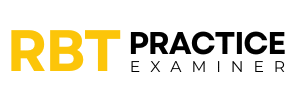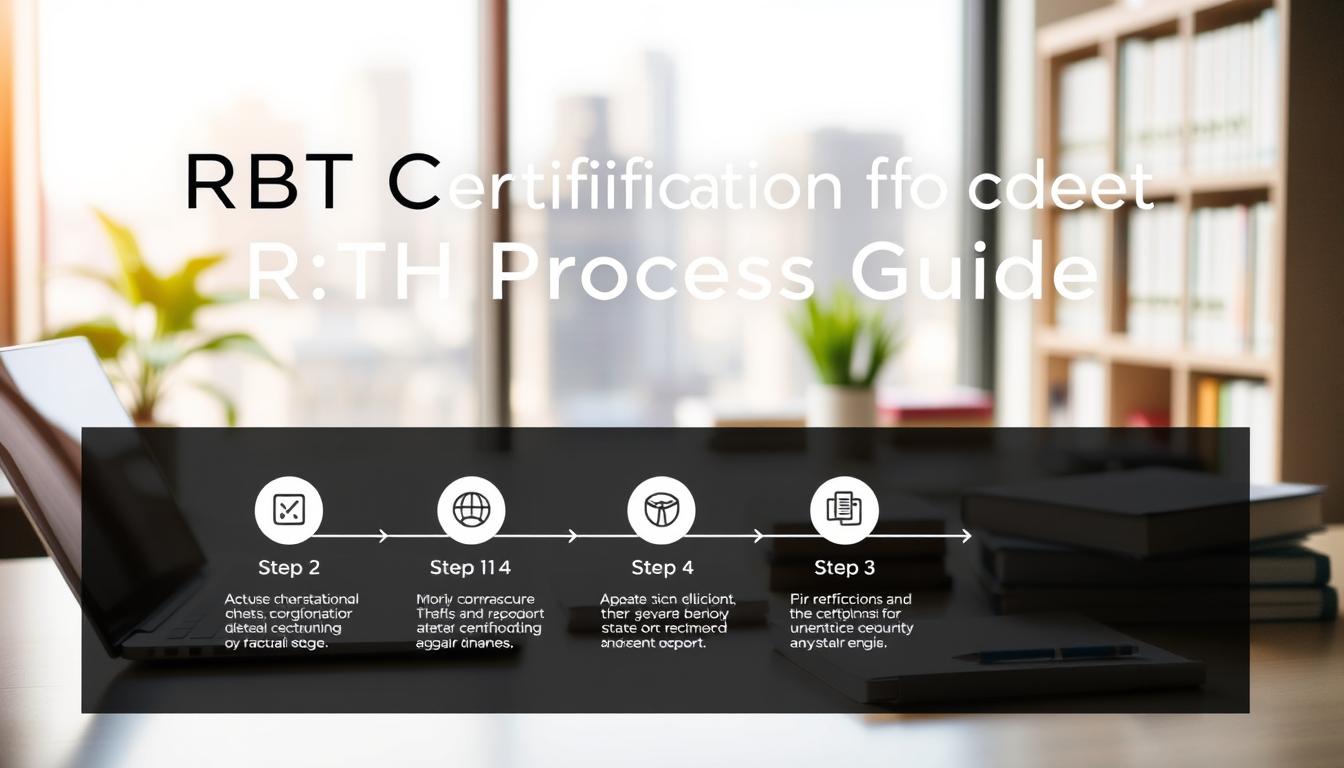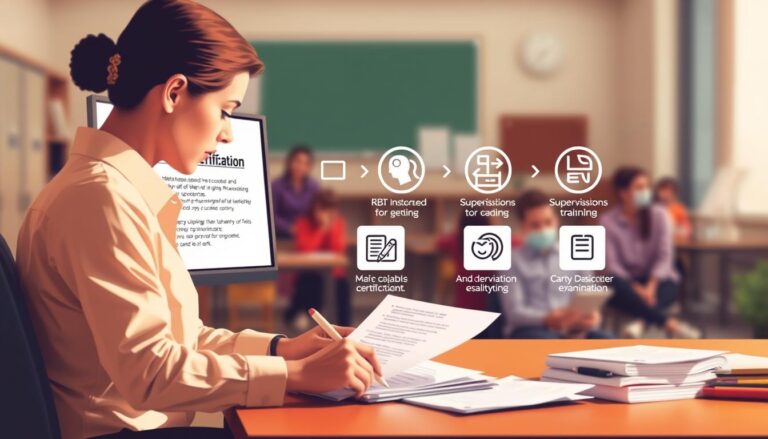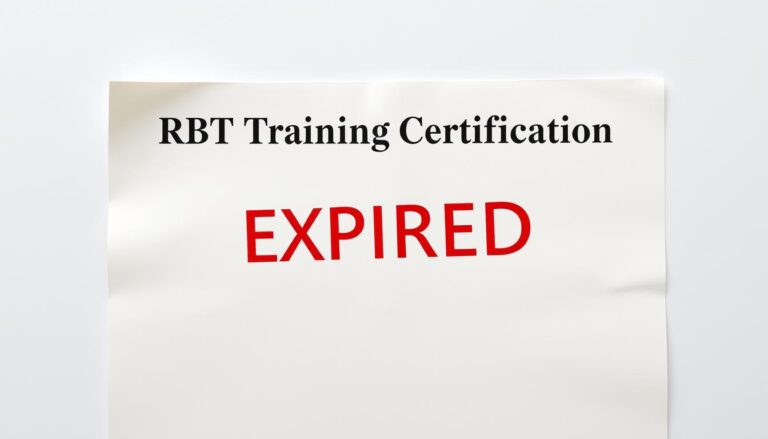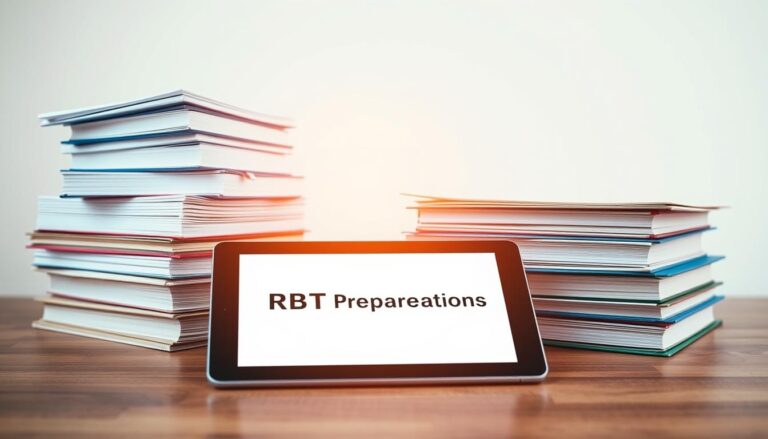Get Your RBT Certification: A Step-by-Step Guide How and Where to Get
Becoming a Registered Behavior Technician (RBT) opens exciting career paths in Applied Behavior Analysis (ABA) therapy. If you’re wondering where to get your RBT certification, this guide will walk you through every critical step of the registered behavior technician certification process.
RBT certification is a professional credential for those passionate about supporting individuals with autism and developmental disabilities. It shows your commitment to high-quality behavioral intervention techniques. It also provides a structured pathway into the rewarding field of ABA therapy.
Professionals seeking to understand where can I get my RBT certification will find multiple training options. These include online programs, in-person workshops, and hybrid learning experiences. They cater to different learning styles and schedules.
Pursuing RBT certification requires dedication, specific educational prerequisites, and successful completion of a training and examination process. Our guide will break down each requirement. It will help you navigate the certification journey with confidence and clarity.
Whether you’re a recent graduate, career changer, or healthcare professional looking to expand your skills, this guide provides the essential roadmap to becoming a certified Registered Behavior Technician.
Understanding the Role of a Registered Behavior Technician
Becoming an RBT is an exciting career for those who love helping people with developmental challenges. It takes dedication, special training, and a real passion for ABA therapy certification.
Registered Behavior Technicians are key in ABA therapy. They work with certified analysts to carry out treatment plans. They help people with autism spectrum disorders.
Core Responsibilities and Daily Tasks
RBTs have important jobs that help clients grow. Their daily tasks include:
- Implementing behavior intervention plans
- Collecting and recording behavioral data
- Providing direct one-on-one therapy sessions
- Communicating with supervisors about client progress
- Maintaining professional documentation
Career Opportunities in ABA Therapy
ABA therapy offers many career paths for RBTs. They can work in different settings and with different groups. This lets them grow their skills over time.
| Career Setting | Typical Responsibilities |
|---|---|
| Schools | Supporting students with behavioral challenges |
| Clinics | Conducting structured therapy sessions |
| Home-Based Services | Providing individualized intervention strategies |
Working with Autism Spectrum Disorders
RBTs focus on helping people with autism. They use evidence-based techniques to improve communication, social, and adaptive skills. Their work needs patience, empathy, and a deep understanding of behavior.
To become an RBT, you need thorough training, supervised experience, and a commitment to ongoing ABA therapy certification.
Essential RBT Certification Requirements
To become a Registered Behavior Technician (RBT), you must meet certain requirements. These ensure you’re ready to give top-notch behavioral therapy. The path to becoming a certified behavior therapist is set to keep standards high and protect clients.
Here are the main requirements for RBT certification:
- Minimum age of 18 years old
- High school diploma or equivalent educational credential
- Successful completion of a background check
- 40-hour training program in applied behavior analysis (ABA)
- Passing the official RBT competency assessment
The RBT certification requirements are made to set a strong professional standard. You need to finish specific training modules. These cover important topics like behavioral intervention, client interaction, and ethics.
The educational needs are clear but important. You don’t need a college degree, but you must show you understand basic education and have good people skills. The certification process makes sure you’re ready to work with different people, like those with autism spectrum disorders.
Future RBTs should be ready to spend time on detailed training and keep learning. The certification process is tough but aims to make skilled professionals. These professionals can really help improve clients’ lives.
Where Can I Get My RBT Certification: Top Accredited Programs
Getting your Registered Behavior Technician (RBT) certification needs careful choice of training. There are many ways to get your RBT certification, fitting different learning styles and schedules.
Looking for where to get your RBT certification? You’ll find three main ways:
- Online Certification Options
- In-Person Training Programs
- Hybrid Learning Opportunities
Online Certification Options
Digital learning has changed RBT certification training. Online programs are flexible for those working and studying. They offer full virtual courses that meet BACB standards.
Online certification has big benefits:
- Learn at your own pace
- Access from anywhere
- Usually cheaper
- High-quality curriculum
In-Person Training Programs
Classroom learning is also popular for RBT certification. It offers direct contact with experts and practical training. Local schools, training centers, and clinics often have in-person courses.
Hybrid Learning Opportunities
Hybrid programs mix online and in-person training. You do theory online and practical training in person. This mix offers both convenience and thorough skill building.
The Complete RBT Training Process Explained
Starting your path to become a Registered Behavior Technician (RBT) needs a clear training plan. RBT training programs give you the skills to help people with behavioral issues.
The steps to become an RBT are key:
- Complete a 40-hour training course from a BACB-approved provider
- Pass a background check
- Obtain a qualified supervisor in ABA therapy
- Complete hands-on practical experience
- Pass the official RBT certification exam
To become an RBT, you must learn important skills. The training covers:
- Ethical considerations in behavioral therapy
- Measurement and documentation techniques
- Behavior reduction strategies
- Communication skills with clients and families
Good RBT training programs focus on practical skills. You learn to apply behavior plans, collect data, and work with BCBAs.
Every training program might be a bit different. But the main goal is always the same: to prepare caring, skilled professionals. They can really help people’s lives.
Cost Breakdown of RBT Certification Programs
Getting a registered behavior technician certification has several costs. Knowing all the costs helps you plan your career. The cost of RBT certification online changes based on different things.
Understanding the money side of becoming a registered behavior technician is key. Let’s look at the main costs you’ll face during your journey.
Training Program Fees
Online RBT certification programs cost between $100 and $500. Prices vary based on:
- Course length
- Training provider’s reputation
- How complete the curriculum is
- Extra study materials
Examination Costs
The Behavior Analyst Certification Board (BACB) has a set fee for the exam. You’ll need to save for:
| Expense Category | Estimated Cost |
|---|---|
| Exam Registration | $50 – $75 |
| Study Materials | $30 – $150 |
| Practice Tests | $25 – $75 |
Maintenance and Renewal Expenses
Keeping your certification up to date costs money. Expect to spend:
- Renewal application fees
- Continuing education credits
- Background check updates
Plan to spend $150-$300 a year to keep your RBT certification.
Preparing for Your RBT Competency Assessment

The RBT competency assessment is a key step in your journey to become a certified ABA therapist. It checks if you have the skills to offer top-notch behavioral intervention services. To prepare well, you need a solid plan and focused study.
Here are the main steps to do well in your RBT certification:
- Learn the Registered Behavior Technician Task List inside out
- Get hands-on practice with supervised training
- Go through all the study materials carefully
- Know the ethical rules and professional standards
Your test will have both practical and theoretical parts. The practical part checks if you can use behavior intervention techniques right. You’ll show you can collect data, reduce behavior, and communicate well.
Here are some tips to get ready:
- Finish a detailed RBT training program
- Get advice from seasoned ABA experts
- Practice with mock test scenarios
- Keep a record of your clinical work
Getting your RBT certification takes hard work and good preparation. Focus on improving your practical skills and understanding behavioral intervention. This will help you pass the competency test.
Tips for Passing the RBT Certification Exam
Getting ready for your Registered Behavior Technician (RBT) certification exam needs careful planning and focused study. Aspiring behavior therapists must have a detailed plan to pass this important step.
Study Strategies and Resources
Creating good study strategies is key when getting ready for your behavior therapist certification. First, gather the right materials to help you learn:
- Use official BACB® study guides and practice materials
- Join online study groups specific to RBT certification
- Watch video tutorials from experienced ABA professionals
- Review recommended textbooks and clinical practice resources
Practice Test Guidelines
Practice tests are vital for understanding how to become an RBT. They help you:
- Familiarize yourself with exam format and question types
- Identify knowledge gaps
- Build confidence in test-taking skills
- Improve time management during the actual exam
Time Management During the Exam
Managing your time well can greatly affect your RBT certification exam score. Here are some tips:
- Read each question carefully before selecting an answer
- Allocate approximately 1-2 minutes per question
- Mark difficult questions to review later
- Leave time for a final review of your answers
Remember, thorough preparation and a calm mindset are essential to pass your RBT certification exam.
Finding a Qualified RBT Supervisor
Finding the right RBT supervisor is key to getting your RBT certification. A good supervisor guides your growth and ensures you meet training program needs.
Look for supervisors with ABA expertise. The right one can greatly impact your certification journey.
- Board Certified Behavior Analyst (BCBA) credentials
- Minimum of 2 years experience in ABA therapy
- Active state licensure
- Strong communication and mentoring skills
Here are some ways to find a qualified RBT supervisor:
- Contact local ABA clinics and treatment centers
- Network with professional ABA associations
- Utilize online job boards specializing in behavioral health
- Attend professional conferences and workshops
| Supervisor Qualification | Importance Level |
|---|---|
| BCBA Certification | High |
| Clinical Experience | Critical |
| Supervision Experience | Essential |
When you find possible supervisors, set up meetings to talk about your RBT certification goals. Discuss their supervision style, availability, and mentoring approach.
A great supervisor helps you get certified and supports your ABA career growth.
Required Documentation and Background Checks
Getting a Registered Behavior Technician (RBT) certification means you need to gather a lot of documents. You’ll need to show your professional and personal details. This is to prove you’re ready for ABA therapy work.
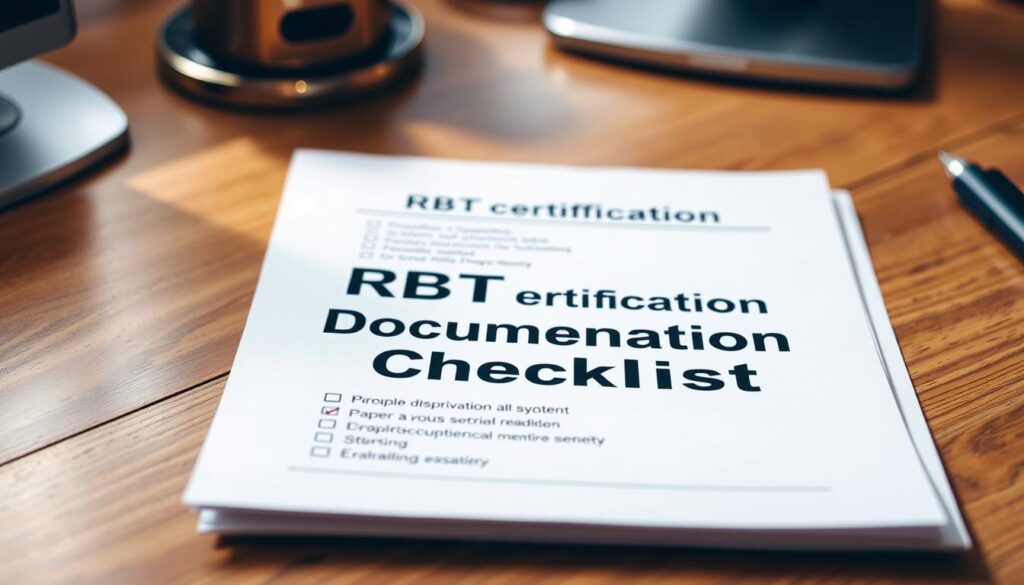
Getting ready for RBT certification is all about the details. You’ll need to give many important documents. These show your professional and personal background.
Criminal Background Verification
Background checks are key for RBT certification. You’ll need to pass a deep criminal background check. This includes:
- State-level criminal record check
- Federal criminal database search
- Sex offender registry screening
- Child abuse registry verification
Educational Transcripts
Your school records are important for RBT certification. You’ll need to provide:
- High school diploma or equivalent
- Official transcripts
- Proof of completed training hours
Professional References
References help show you’re a good fit for RBT work. You’ll need to give:
| Reference Type | Requirements |
|---|---|
| Professional Reference | Written recommendation from supervisor or professional mentor |
| Academic Reference | Letter from educational institution or instructor |
| Character Reference | Recommendation highlighting personal qualities relevant to ABA therapy |
Tip: Make sure all your documents are up-to-date, clear, and show your true professional background. This is important for accredited RBT programs.
Maintaining Your RBT Certification
Keeping your registered behavior technician certification active needs ongoing effort and dedication. The Behavior Analyst Certification Board (BACB) has clear rules for continuing your ABA therapy certification. These rules help you stay precise and excellent in your work.
To keep your certification, you must follow several important steps:
- Renew certification annually
- Complete required continuing education units
- Maintain ethical professional standards
- Pass periodic competency assessments
The renewal process for RBT certification shows you’re up to date in applied behavior analysis. RBTs need to get specific continuing education hours. This keeps them current with the latest ABA practices.
| Certification Maintenance Requirements | Details |
|---|---|
| Annual Renewal Fee | $35 – $50 |
| Continuing Education Units | 4 hours annually |
| Supervision Hours | 5% of active supervision time |
RBT professionals should keep a close eye on their certification status. Managing your credentials well ensures you can keep working in ABA therapy without pause.
Staying updated with new behavioral intervention methods is key for RBTs. It helps them offer the best support to those with developmental challenges. Regular training and growth are vital for keeping your RBT certification.
Professional Development Opportunities for RBTs
As a Registered Behavior Technician (RBT), growing your career means always learning and improving. The world of applied behavior analysis is full of chances to learn and get better at your job. This is true for those aiming to get certified as a behavior therapist.
If you want a long-term career as an RBT, keep learning and getting special training. Getting certified is just the first step. There’s much more to do after that.
Continuing Education Requirements
To keep your RBT certification, you must meet certain education rules:
- Complete annual professional training hours
- Attend workshops and conferences
- Participate in skill-building seminars
- Stay updated with latest ABA research
Advanced Certification Paths
RBTs can look into several advanced certifications to boost their career:
- Board Certified Assistant Behavior Analyst (BCaBA)
- Specialized autism intervention certifications
- Advanced behavioral intervention techniques
- Leadership and supervisory training programs
Investing in your professional growth can lead to better jobs and more career choices in behavior therapy.
Common Challenges in RBT Certification Process
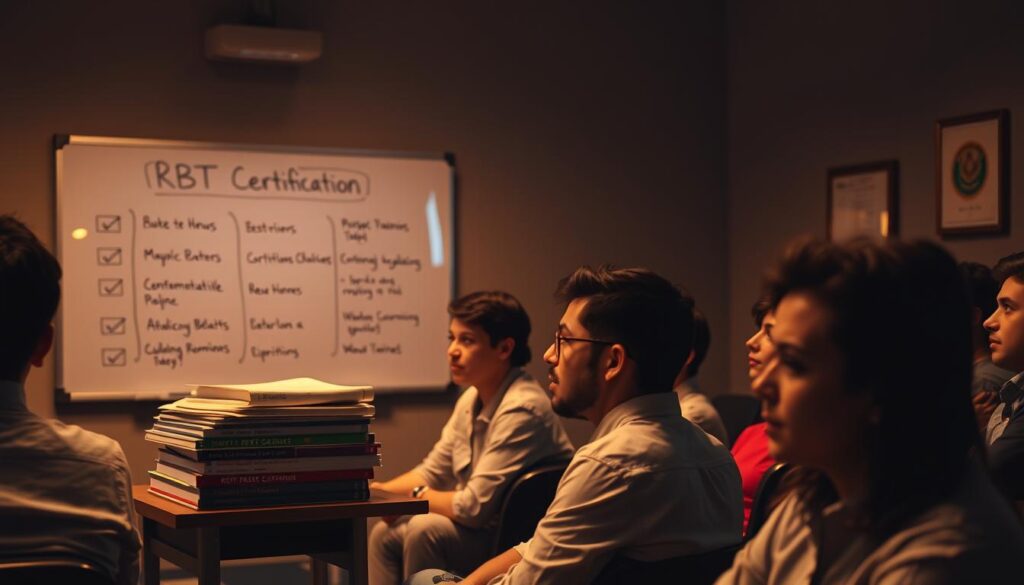
Getting your rbt certification online can be tough. Aspiring Registered Behavior Technicians face many challenges. They need to be well-prepared and strategic.
When looking for where can i get my rbt certification, candidates usually meet these main obstacles:
- Rigorous training requirements
- Complex examination process
- Supervision and documentation challenges
- Time management difficulties
- Financial constraints
Training is a big challenge. The course is deep and requires a lot of study and emotional strength. Many find it hard to balance work and study.
Money can also be a problem. Certification costs, including training and exam fees, can be a big financial burden. It’s important to plan your budget and look for scholarships or help from employers.
Finding a good supervisor is another big challenge. You need to find someone who can guide you well. This requires good networking and communication skills.
- Research multiple training providers
- Create a structured study plan
- Connect with professional networks
- Seek mentorship opportunities
Success comes from being patient, prepared, and proactive. Knowing the challenges helps you plan better for the RBT certification process.
State-Specific Requirements for RBT Practice
Getting a Registered Behavior Technician (RBT) certification can be tricky. Each state has its own rules for RBTs. It’s key for those wanting to work in applied behavior analysis to know these rules well.
States have different rules for RBTs, so your path to certification might change based on where you live. Programs that are approved for RBTs usually help you understand these rules.
- Research your state’s specific licensing board
- Verify local background check protocols
- Confirm continuing education expectations
- Check supervision requirements
Some states have stricter rules than others. These extra rules might include:
| State | Additional Requirements | Supervision Hours |
|---|---|---|
| California | State-specific ethics training | 5 extra supervision hours |
| Florida | Background screening | 4 additional supervision hours |
| New York | Child abuse identification training | 6 extra supervision hours |
If you’re looking to get an RBT certification, reach out to your state’s behavioral health board. Knowing the latest local rules helps make the certification process easier.
The Behavior Analyst Certification Board (BACB) website is a great place to find state-by-state info on RBT certification rules.
Job Placement After RBT Certification
Getting your RBT certification opens up many career doors in Applied Behavior Analysis (ABA) therapy. New RBTs can look forward to a fulfilling job field with lots of options.
With your ABA therapy certification, you can work in many places. This is great for those who want to help people with developmental challenges.
Salary Expectations
RBT salaries change based on where you work, how long you’ve been doing it, and your experience. You can expect to earn a good salary:
| Experience Level | Annual Salary Range | Geographic Variation |
|---|---|---|
| Entry-Level | $30,000 – $40,000 | Lower in rural areas |
| Mid-Level | $40,000 – $50,000 | Higher in urban centers |
| Experienced RBTs | $50,000 – $60,000 | Additional certifications boost earnings |
Career Advancement Options
- Pursue Board Certified Behavior Analyst (BCBA) certification
- Specialize in specific developmental disorders
- Transition into clinical leadership roles
- Develop expertise in specialized intervention techniques
Employment Settings
RBT training programs prepare you for many work places:
- Autism treatment centers
- Schools and educational institutions
- Private therapy practices
- Residential care facilities
- Home-based intervention programs
Your RBT certification is a big step in your career. It sets you up for a rewarding job helping people with developmental needs.
Conclusion
Getting a registered behavior technician certification is a big step in the field of applied behavior analysis. It takes hard work, planning, and a real love for helping people with developmental challenges.
Your certification lets you work in autism intervention and behavioral health services. You’ll need to finish training, pass tough tests, and keep up high standards. This way, you become a key support for people learning important life skills.
Getting certified as a behavior therapist takes dedication but pays off well. Those who keep learning and growing in their careers make a big difference. They help in clinics, schools, and community programs.
ABA therapy is growing, and there’s a big need for skilled technicians everywhere. By knowing how to get certified, always learning, and focusing on patients, you can have a rewarding career. You’ll make a real difference in people’s lives.
